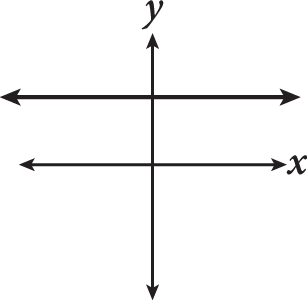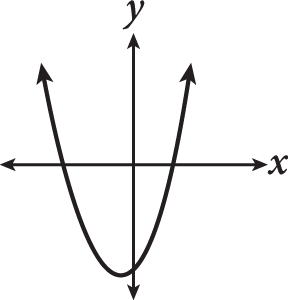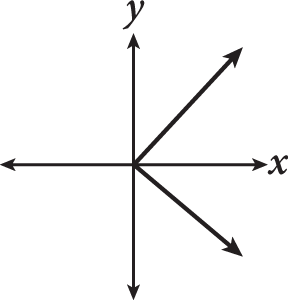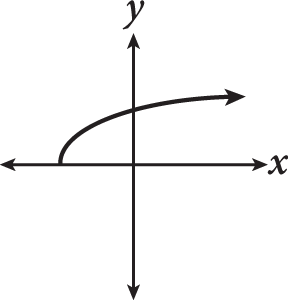Extra Practice
-
If k(x) = 5x + 2, then what is the value of k(4) − k(1) ?
- 15
- 17
- 19
- 21
-
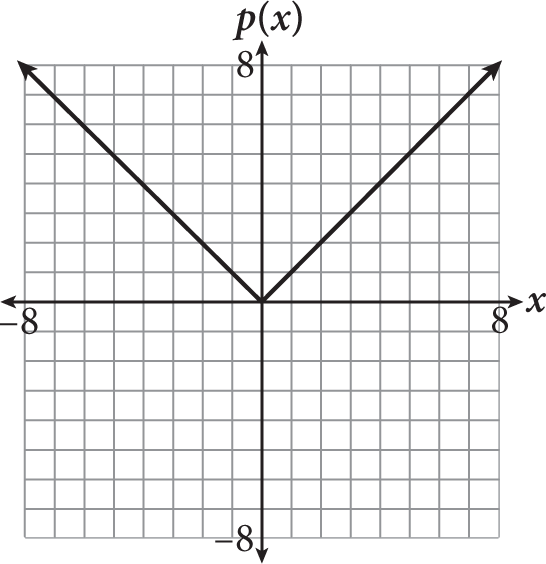
-
The figure shows the function p(x) = | x |. Which statement about the function is not true?
- p(0) = 0
- p(− 4) = 4
- p(4) = − 4
- The domain of p(x) is all real numbers.
-
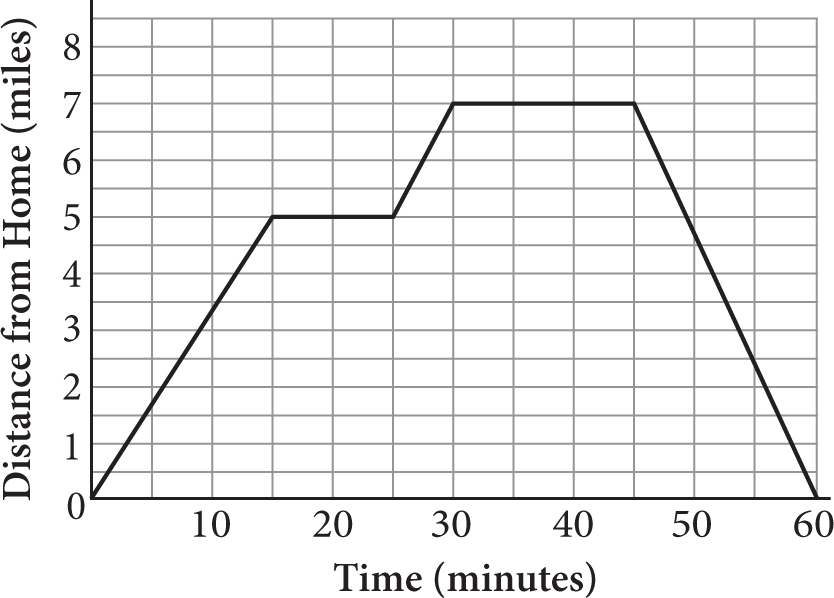
-
The graph above shows Carmel’s distance from home over a one-hour period, during which time he first went to the library, then went to the grocery store, and then returned home. Which of the following statements could be true?
- The grocery store is about 5 miles from Carmel’s house.
- Carmel traveled a total of 7 miles from the time he left home until he returned.
- The grocery store is 7 miles farther from Carmel’s house than the library is.
- Carmel spent 10 minutes at the library and 15 minutes at the grocery store.
-
If the graph of a function g(x) passes through the point (5, 3), and h(x) is defined as h(x) = −g(x − 2) + 8, through which point does the graph of h(x) pass?
- (−3, 11)
- (3, 5)
- (7, 5)
- (7, 11)
-
x g(x) x h(x) −6 −3 0 6 −3 −2 1 −4 0 −1 2 2 3 0 3 0 6 1 4 −2 -
Several values for the functions g(x) and h(x) are shown in the tables above. What is the value of g(h(3)) ?
- −1
- 0
- 3
- 6
-
If p is a function defined over the set of all real numbers and p(x + 2) = 3x 2 + 4x + 1, then which of the following defines p(x) ?
- p(x) = 3x 2 − 7x + 3
- p(x) = 3x 2 − 8x + 5
- p(x) = 3x 2 + 16x + 9
- p(x) = 3x 2 + 16x + 21
-
A company uses the function P(x) = 150x − x 2 to determine how much profit the company will make when it sells 150 units of a certain product that sells for x dollars per unit. How much more profit per unit will the company make if it charges $25 for the product than if it charges $20 ?
-
The customer service department of a wireless cellular provider has found that on Wednesdays, the polynomial function C(t) = −0.0815t 4 + t 3 + 12t approximates the number of calls received by any given time, where t represents the number of hours that have passed since the department opened at 7 AM. Based on this function, how many calls can be expected by 5 PM ?
-
If g(x) = −2x 2 + 7x − 3, what is the value of g(−2) ?
- −25
- −9
- −1
- 3
-
Which of the following does not represent the graph of a function?
-
A biologist is studying the effect of pollution on the reproduction of a specific plant. She uses the function n(p) to represent these effects, where p is the number of seeds germinated by the test group of the plant over a given period of time. Which of the following lists could represent a portion of the domain for the biologist’s function?
- {… −150, −100, −50, 0, 50, 100, 150…}
- {−150, −100, −50, 0, 50, 100, 150}
- {0, 0.25, 0.5, 0.75, 1, 1.25, 1.5…}
- {0, 20, 40, 60, 80…}
-
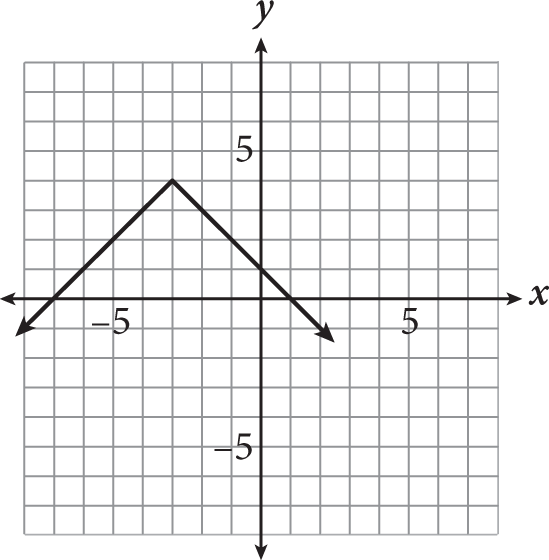
-
The graph of f (x) is shown above. Which of the following represents the domain and range of the function?
- Domain: f(x) ≥ 4; Range: all real numbers
- Domain: f(x) ≤ 4; Range: all real numbers
- Domain: all real numbers; Range: f(x) ≥ 4
- Domain: all real numbers; Range: f(x) ≤ 4
-
If g(x) = (x − 2)2 − 5, which of the following statements is true?
- The function g(x) is increasing over the entire domain.
- The function g(x) is decreasing over the entire domain.
- The function g(x) is increasing for x < 2 and decreasing for x > 2.
- The function g(x) is decreasing for x < 2 and increasing for x > 2.
-
A function is defined by the equation
 . For this function, which of the following domain values corresponds to a range value
of 14 ?
. For this function, which of the following domain values corresponds to a range value
of 14 ?- − 4
- 10
- 38
- 100
-

-
For the piecewise function f (x) defined above, what is the value of f (−3) ?
- −3
- 7
- 10
- −3, 7, and 10
-
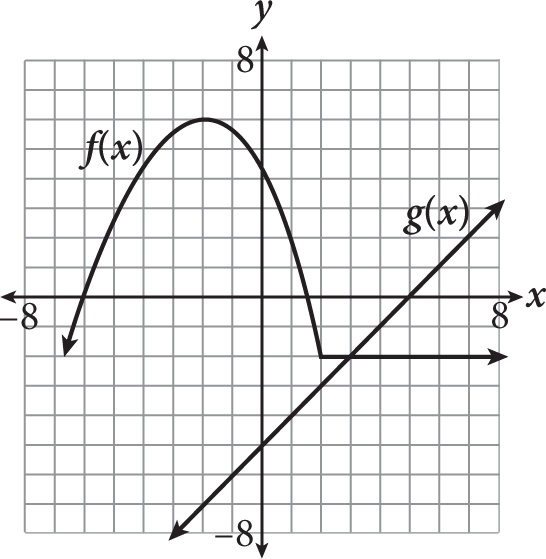
-
Based on the figure above, what is the value of f (−2) + g(2) ?
- −3
- 0
- 3
- 6
-
If f (x) = 3 − x and
 , which of the following is not in the range of f (g(x)) ?
, which of the following is not in the range of f (g(x)) ?- −3
- 0
- 2
- 4
-
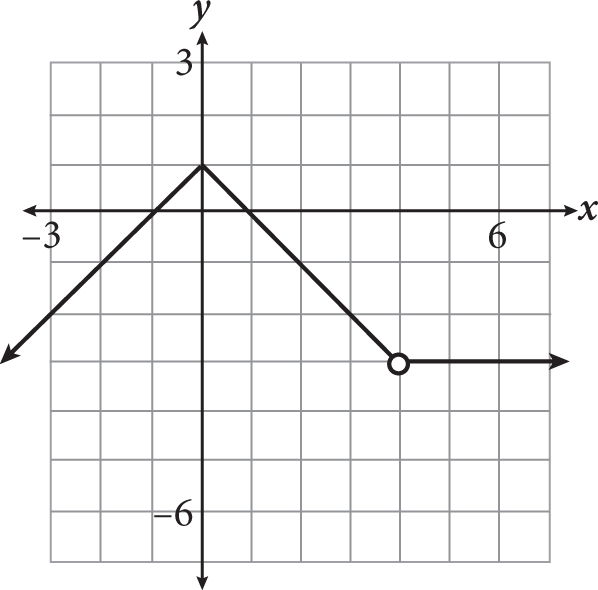
-
Which of the following piecewise functions could have been used to generate the graph above?
-
